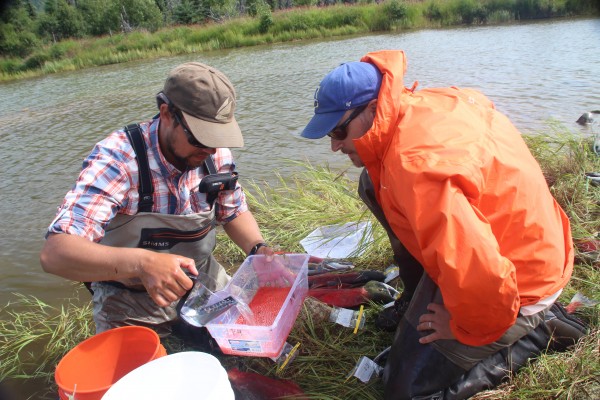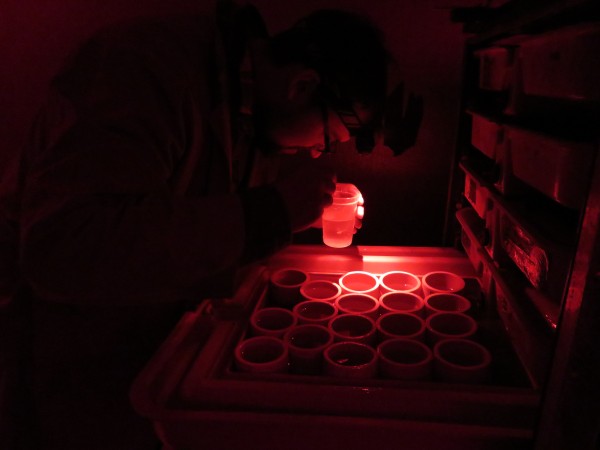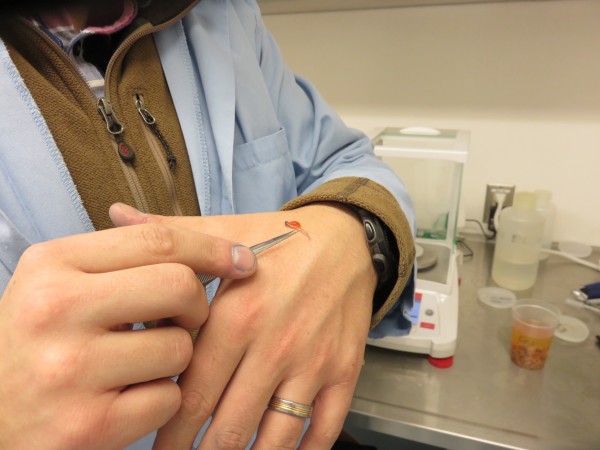Sockeye study looks at adaptability to warming temperatures
February 19, 2016
Lauren Frisch
907-474-5022
Preliminary results of a study by University of Alaska Fairbanks researchers indicate
that it will be important for sockeye salmon populations to maintain genetic diversity
so they can adapt as water temperature changes.
This is important in Alaska because sockeye salmon are fished commercially all along
the southern and western coasts of the state. The world’s largest sockeye harvest
is in Bristol Bay.

“Taking care of 50,000 babies is a lot of work,” said Morgan Sparks, a master’s student at the UAF School of Fisheries and Ocean Sciences. Sparks is responsible for sockeye salmon eggs that were fertilized at Lake Iliamna near Bristol Bay in summer 2015, and then raised at the UAF Biological Research and Diagnostics Facility.
Sparks is working with SFOS Assistant Professor Peter Westley and Jeff Falke, Alaska Cooperative Fish and Wildlife Research Unit assistant professor, to study the potential for sockeye salmon to adapt to changes in water temperature by modifying hatch timing.
They are collaborating with the University of Washington Alaska Salmon Program, with funding from the Western Alaska Landscape Conservation Cooperative.
“At the most basic level, hatch timing is dictated by temperature more than anything else,” Sparks said. Fish are cold-blooded, so their body temperature and metabolism depend on water temperature. When the water temperature is warmer, metabolism tends to be quicker, and vice versa.
During one long day in the field, the researchers fertilized eggs from two populations in Lake Iliamna in the Kvichak River watershed. One population spawns in the groundwater-fed Pedro Ponds just off Lake Iliamna, where water temperature is typically cold and constant throughout development. The other population spawns on the shores of Woody Island in Lake Iliamna, where water temperature is more variable throughout development.

The researchers collected 10 adult females and 20 males from each location, creating 10 families of one female and two males for each population. Fertilized eggs were flown directly from Bristol Bay to Fairbanks in a chartered plane.
In the lab, Sparks is studying when embryos hatch in five temperature-controlled chambers replicating various temperature conditions for the two study sites. Two chambers are set up to replicate conditions at Pedro Ponds and Woody Island based on historical data. Two more chambers have warmer-than-average temperatures to reflect potential future conditions at the sites. One chamber replicates colder historical conditions from the Woody Island population. Eggs from each family were placed in each of the temperature-controlled chambers to control for genetic variability in each family.
Initial results show that hatch timing varies for eggs among families within the two populations, suggesting the embryo’s parents, rather than the population the egg came from, have the strongest influence on hatch timing.
Westley anticipates this research will ultimately reveal that sockeye salmon have a high capacity to be resilient in the face of temperature change. He hypothesizes that the ability to modify hatch timing could allow sockeye salmon to successfully adapt to warming water temperatures.

ADDITIONAL CONTACTS: Morgan Sparks, msparks1309@gmail.com; Peter Westley, pwestley@alaska.edu, 907-474-7458.
For more information, see a longer version of this story on the SFOS website: https://web.sfos.uaf.edu/wordpress/news/?p=2161.


